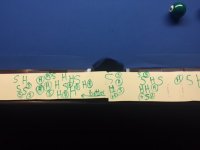[...] Mike, if possible, make it a double-blind experiment by getting a third party, who is not involved in the experiment, to label the cues A and B, and make sure they're the only party to know which cue has which tip. This will prevent any of your subconscious signals to the player about which cue is which.
Well I didn't do that. I had him shoot three shots with one cue, then three with the other, then back to the first one, etc. Later I just handed him a cue randomly for each shot, and he didn't know what he had. Those are the circled results.
Marks more to the left are the good ones. Zero is the best. When I average the results, I get 9.2 (inches) for S (Kamui Super Soft) and 9.3 for H (Kamui hard). So on average, for all these attempts for maximum "action," the two tips performed the same.
But I noticed two things.
(1) 6 of the 7 "best" outcomes were from the soft tip, including the best three "blind" outcomes.
(2) I wish in retrospect I counted miscues for each tip. My perception is there were MANY more miscues for the hard tip, even though we chalked carefully and scruffed the tips frequently.
he was trying for the limit, and overall I'd say he miscued about one in three times (which is what we want).
In the second half of the experiment, the blind half, I gave him a random cue after a miscue. So even if he was a little shy following a miscue, it should affect the results equally.
These results are preliminary, but they suggest the miscue limit may be tighter for a hard tip.
So the preliminary conclusion is hard tips and soft tips appear to give the same spin-to-speed ratio, and the miscue limit may be more liberal for a soft tip.
I'll try to get some more results, making them all blind next time and recording the miscues for each tip.
Once again, I used identical cues (brand, length, weight, markings) both with new Kamui tips (Super Soft and Hard) cut down to the same size and both shaped with the nickle on a cue cube.
